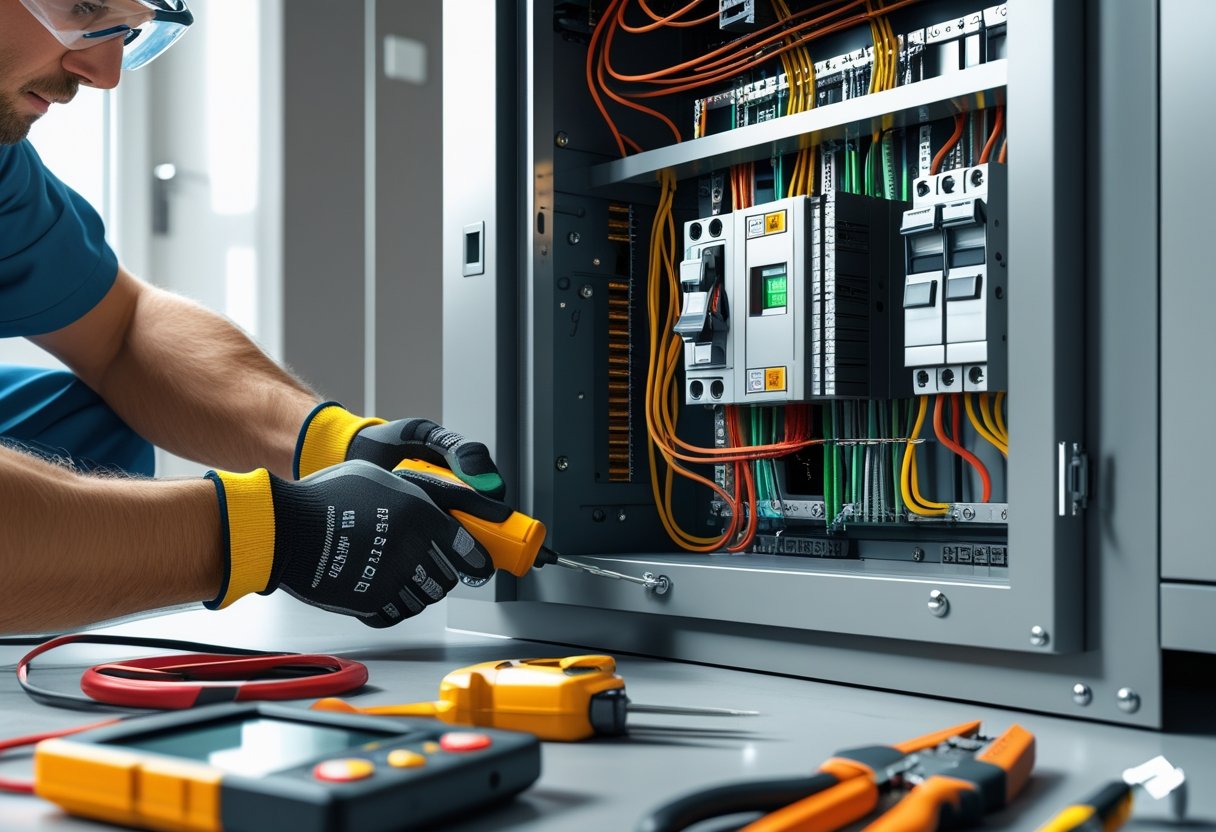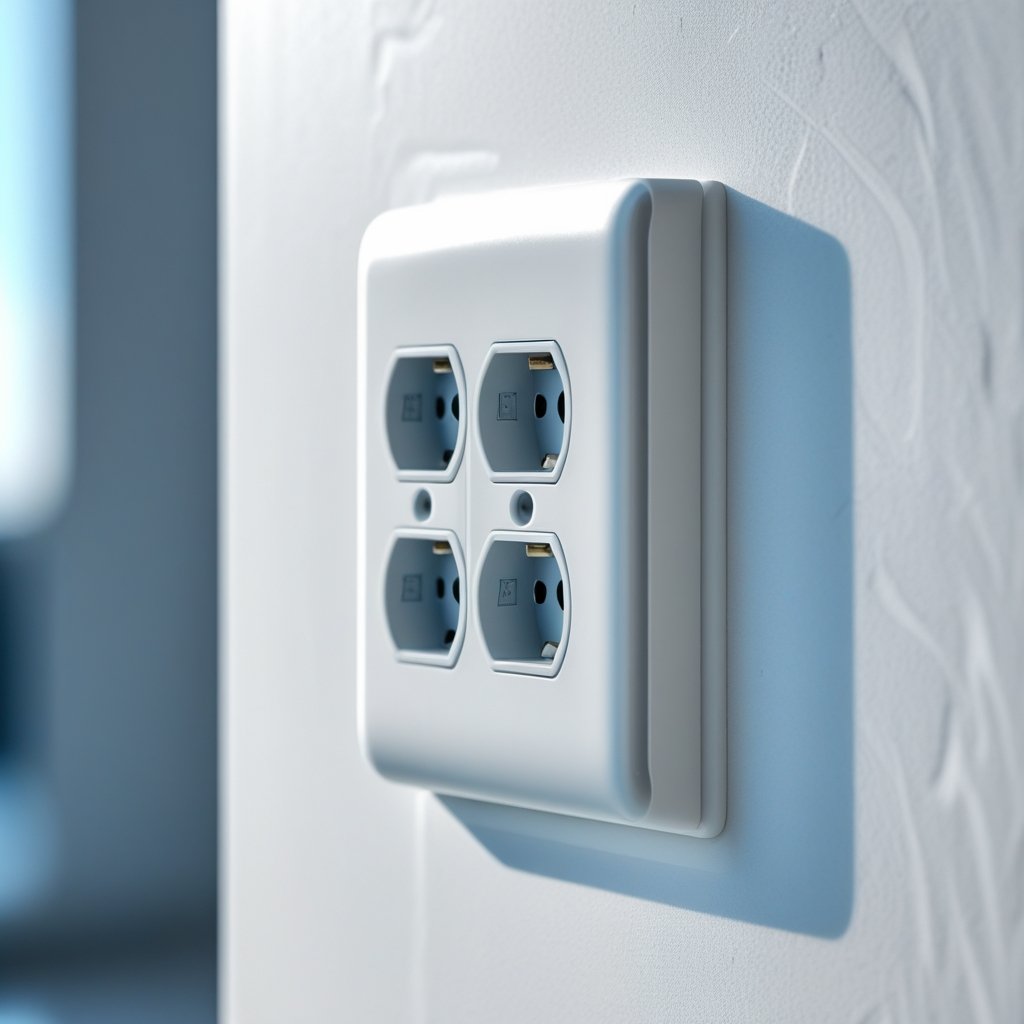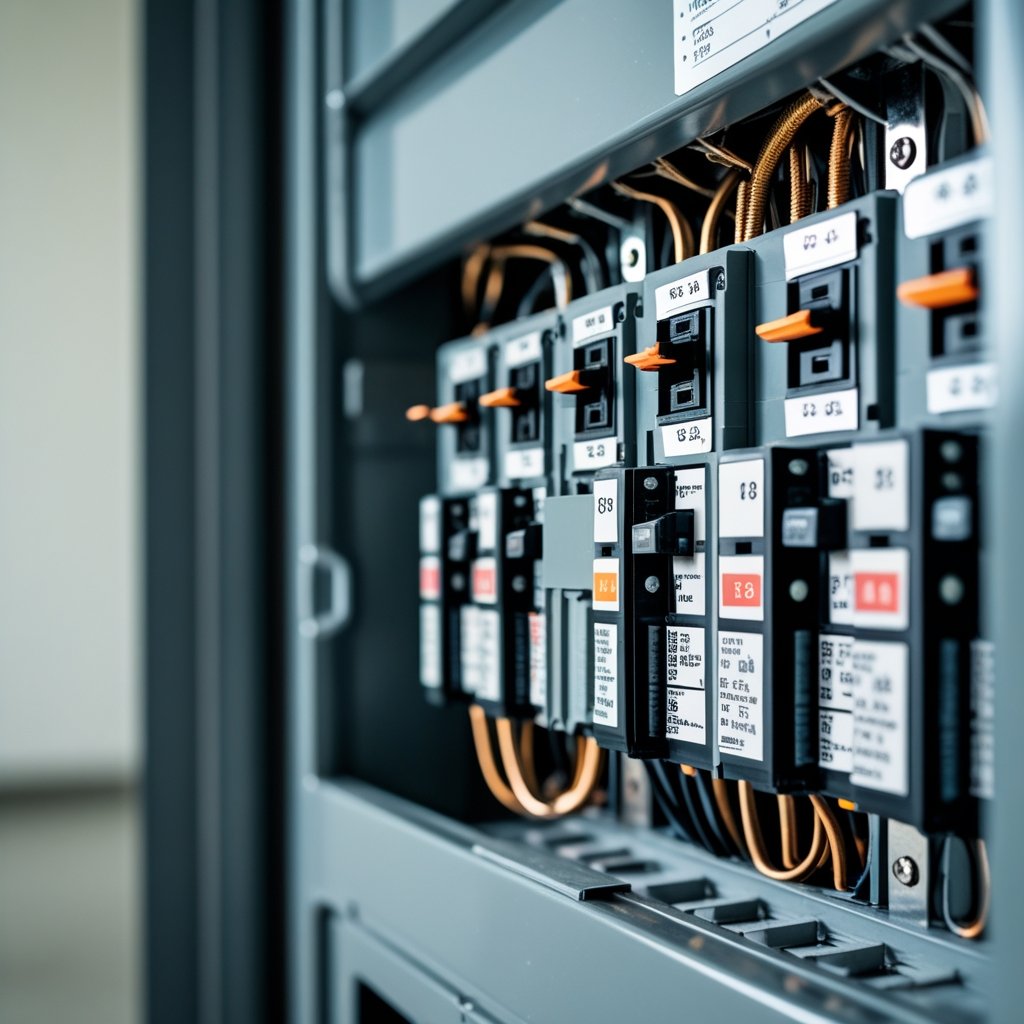Upgrading your electrical panel typically costs between $850 and $3,000, depending on the amperage and the complexity of the installation. This investment ensures your home’s electrical system can safely handle modern power demands, preventing outages and reducing fire risks.
At AAA Electrical Services, we prioritize your family’s safety with flat-rate pricing and same-day service throughout Sacramento and nearby communities. Whether you need a simple panel repair or a full upgrade, our licensed technicians arrive prepared with stocked vans for fast, reliable work that minimizes disruption.
Understanding the costs and benefits of an electrical panel upgrade helps you make an informed decision about your home’s safety and capacity. With over 42 years of experience, we’re here to guide you step-by-step toward a safer, more efficient electrical system.
Average Electrical Panel Upgrade Cost
The cost to upgrade your electrical panel depends primarily on the panel size, whether you’re replacing just the panel or doing full installation, and additional expenses such as labor and permits. Knowing these details helps you plan your budget and understand what to expect from licensed electricians.
Typical Cost Ranges by Panel Size
Electrical panel upgrades vary by amperage. A 100-amp panel upgrade typically costs between $850 and $1,600. If you need a 200-amp panel, expect to pay around $1,300 to $3,000. Larger capacity panels, such as 400-amp upgrades, can range from $2,000 to $4,000, depending on your home's power requirements.
These price ranges reflect differences in materials and system complexity. If your home uses more electrical appliances or technology, a higher amperage panel is often necessary. AAA Electrical Services offers tailored panel upgrades in Sacramento and nearby areas, matching your home’s specific needs.
Panel-Only vs Full Installation Costs
If your upgrade involves replacing only the electrical panel, costs tend to be lower, usually toward the lower end of the range for your panel size. This option is more straightforward if the existing panel location and wiring remain suitable.
Full installation costs increase if the panel needs to be relocated or if significant rewiring is required. Relocation involves added materials and labor, which can push the price upwards by several hundred dollars. A full installation typically includes removing the old panel, installing the new one, and updating breakers to ensure safety and capacity.
Labor and Permit Expenses
Labor makes up a significant portion of the electrical panel upgrade cost. Licensed electricians charge for their expertise, time, and ensuring compliance with safety standards. For a typical upgrade, labor can add between $500 and $1,200.
Permit fees and inspections are usually required by local building codes and can range from $50 to $300, depending on your location. Working with professionals like AAA Electrical Services means you're guaranteed licensed, insured, and state-certified technicians who handle all permits and inspections, providing peace of mind with your family’s safety as a priority.
Factors Influencing Electrical Panel Upgrade Cost
The cost of upgrading your electrical panel depends on multiple specific factors related to the size of the panel, the complexity of the work, and any changes needed to wiring or equipment. Each factor can impact labor and material costs, so understanding these details will help you plan your budget accurately.
Panel Size and Amperage
The size of your electrical panel, measured in amperage, directly affects upgrade costs. Common residential panels range from 100 to 200 amps. Upgrading from a 100-amp to a 200-amp panel typically costs between $1,300 and $3,000 due to the need for a larger main breaker and possibly more circuit breaker slots.
A larger amperage panel supports greater power loads, which is necessary for modern homes with electric vehicles, HVAC systems, or increased demand for devices. Upgrading to the right panel size ensures safety and future-proofing but involves more expensive components and labor.
Complexity of Installation
Installation complexity affects the time and expertise required, impacting cost. If your existing panel is outdated or in poor condition, technicians must take extra precautions, potentially replacing the main breaker or upgrading your circuit breaker panel entirely.
Difficult access, such as panels installed in tight spaces or older homes with outdated electrical wiring, adds labor hours. Permits and inspections may be mandatory, especially if the work involves bringing your system up to current code.
AAA Electrical Services offers flat-rate pricing with licensed, certified electricians to handle complex installations efficiently while ensuring your family’s safety.
Location and Relocation Costs
If your electrical panel needs to be relocated within your home, expect higher costs. Moving a panel involves rerouting the electric meter box connection, running new conduit, and repairing walls or finishes.
Costs fluctuate based on distance and obstacles between the original and new locations. Relocation may require permits and inspection fees and takes more time, increasing labor charges. For homeowners in Sacramento or nearby areas, fast, same-day service from AAA Electrical Services can minimize disruption.
Additional Wiring or Meter Upgrades
Upgrading your panel often requires updating or adding electrical wiring, especially if your current system uses outdated cables or shorts of conduit paths. Adding new branch circuits or installing heavier-gauge wiring raises material and labor costs.
Sometimes the electric meter box must be upgraded to match the new panel’s amperage rating. Meter upgrades may involve coordination with your utility company and can add permitting fees.
Having licensed professionals manage your panel upgrade ensures all wiring and meter work meets safety codes, protecting your home and family.
For reliable, safety-first service in Roseville, Rocklin, and neighboring communities, AAA Electrical Services provides expert panel upgrades with transparent pricing and certified technicians.
When to Upgrade Your Electrical Panel
Knowing when your electrical panel needs an upgrade can help prevent safety hazards and keep your home’s power running smoothly. Pay attention to unusual signs, potential risks, and the age of your system to decide if an upgrade is necessary.
Signs Your Panel Needs Replacement
If your breaker trips frequently or your lights flicker often, these are clear indicators your panel may be struggling. Older fuse boxes can also signal a need for replacement, especially if they can’t handle modern electricity demands.
Other signs include a burning smell near the panel, warm spots on the breaker panel, or visible rust and corrosion. These could mean overheating or internal damage, which raises safety concerns. A panel that can’t support new appliances or EV chargers is also overdue for an upgrade.
Common Electrical Hazards and Risks
Outdated or faulty panels, such as Zinsco panels, are known for causing electrical hazards and increasing fire risks. These issues stem from poor connections and deteriorated parts inside the breaker panel.
Electrical fires often start because panels are overloaded or breaks in wiring allow shorts. Ignoring these risks can lead to costly damage to your home, personal injury, or worse. Professional inspection and repair by companies like AAA Electrical Services will enhance your home’s safety and reduce hazards.
Aging and Obsolete Panels
Panels older than 25-30 years often become obsolete. They lack the capacity to support today’s energy needs and don’t meet current safety codes. Even if you don’t see immediate problems, an aging panel can cause hidden issues that become severe over time.
Technology upgrades, including EV chargers or solar panels, may require you to increase your panel’s amperage. Upgrading ensures your electrical system is reliable and compliant with modern standards, securing your family’s safety and providing peace of mind.
For tailored electrical services focused on your family's safety in Sacramento and nearby areas, contact AAA Electrical Services for expert panel upgrades and repairs.
Types of Electrical Panels and Upgrades
Electrical panels vary by design and capacity, affecting how power is distributed and managed in your home. Your choice depends on current needs, safety, and future expansion, including additions like solar panels or HVAC systems.
Circuit Breaker Panels vs Fuse Boxes
Circuit breaker panels, also called breaker boxes, are the modern standard. They use switches that trip to cut power during overloads or short circuits. This resettable feature protects your home efficiently and safely.
Fuse boxes, which are older technology, use fuses that melt and require replacement after tripping. They typically have lower amperage limits, often 60 to 100 amps, which may not support today’s electrical demands.
Switching from a fuse box to a circuit breaker panel improves safety and allows for higher power capacity. This upgrade also supports modern appliances and devices like power strips, which draw more current than older systems were designed for.
Subpanels and Supplemental Power Needs
Subpanels serve as smaller breaker boxes fed from the main panel. You might install one when you add considerable new electrical loads, such as a detached garage, workshop, or solar panel system.
They help distribute power closer to where it’s needed, reducing voltage drop and allowing for dedicated circuits, such as for HVAC systems or EV chargers. This setup also isolates certain areas for easier maintenance.
If your home’s main panel is full or can’t handle new loads, a subpanel avoids costly full upgrades while expanding your electrical system safely. AAA Electrical Services can install subpanels with your family’s safety as the priority.
Upgrading for Home Improvements and Modern Loads
When remodeling or adding high-demand equipment, upgrading your panel is often necessary. Modern homes usually require 200 amps or more, especially if you use electric heating, kitchen appliances, or smart home technology.
Upgrades might include replacing a 100-amp panel with a 200-amp version or installing smart circuit breaker panels that offer remote control and monitoring. These help manage energy use and increase safety.
Solar panel installations also require compatible panels and sometimes additional breakers. Upgrades improve reliability and allow you to add future power solutions. When you choose a panel upgrade, insist on licensed professionals who provide upfront pricing and same-day service in your area.
Process for Upgrading an Electrical Panel
Upgrading your electrical panel involves a series of precise steps that ensure your home’s electrical system meets safety standards and can handle your power needs. You will work closely with a licensed electrician to assess your current setup, obtain the necessary permits, safely remove the old panel, and complete the installation with a thorough inspection.
Assessment and Permitting
Your first step is a detailed evaluation of your existing electrical system by a licensed electrician. This includes checking the panel size, the condition of wiring, and whether your home needs an upgrade to handle modern electrical demands. The electrician will determine the proper amperage needed, commonly upgrading from 100 amps to 200 amps for growing power loads.
Permits are required for all electrical panel upgrades to ensure compliance with the National Electric Code. Your electrician will handle the paperwork and secure approval from your local building department. Obtaining permits is crucial to avoid fines and ensure the upgrade is inspected and approved. This step safeguards your family’s safety and future home resale value.
Removal of Old Panel
Once permits are secured, the licensed electrician will safely disconnect your home’s power supply before removing the old electrical box and panel. This process demands precision and experience to avoid hazards like electrical shock or damage to your home’s wiring.
Your electrician will carefully label and disconnect each circuit breaker. If your home has outdated or damaged wiring, they may recommend replacing or upgrading it during this phase. Proper disposal of the old panel and debris is included to keep your property clean and safe.
Installation and Inspection
The new electrical panel is installed according to the updated electrical plan and local codes. Your technician will mount the new electrical box, connect circuits, and install breakers to match your household’s needs.
After installation, the panel and all connections undergo a detailed inspection by both the electrician and the local electrical inspector. The inspection verifies that everything is safe, compliant, and functioning correctly.
AAA Electrical Services offers flat-rate pricing and same-day service in Sacramento and surrounding areas, ensuring your upgrade is done efficiently without surprises. Their licensed, certified electricians focus on a safety-first approach to give you peace of mind throughout the process.
Choosing a Professional and Ensuring Safety
Upgrading your electrical panel requires precise expertise and adherence to strict safety standards. Selecting the right professional and understanding essential safety measures protect your home and ensure the upgrade complies with all regulations.
Hiring a Licensed Electrician
You should always hire a licensed electrician for your electrical panel upgrade. A licensed professional has met state requirements and passed rigorous testing to ensure they can perform safe, reliable work.
Licensed electricians carry necessary insurance, reducing your liability if accidents occur. They also understand local regulations in Sacramento and surrounding areas, minimizing code violations and inspection delays.
AAA Electrical Services offers licensed, insured, and background-checked technicians dedicated to delivering safe and efficient panel upgrades. Their fully stocked vans allow most repairs or upgrades on the same day, ensuring minimal disruption to your home.
Importance of Code Compliance
Electrical panel upgrades must comply with the National Electric Code (NEC) to ensure safety and functionality. This code sets minimum standards for wiring, breaker sizes, and installation methods based on your home's electrical load.
Failure to meet NEC requirements can cause serious safety risks such as electrical fires or system failures. It can also lead to failed inspections and fines. A reputable electrician will ensure all upgrades meet code, including proper grounding and breaker sizing.
You can ask your technician for documentation confirming code compliance. This protects your investment and maintains home insurance eligibility.
Routine Maintenance and Panel Lifespan
Regular maintenance extends the life of your electrical panel and prevents costly repairs. Inspect breakers for wear, listen for buzzing sounds, and check for discoloration or heat around the panel.
Electrical panels typically last 25-40 years but should be evaluated sooner if your home’s electrical needs increase or if your panel shows signs of damage. Scheduled inspections by a licensed electrician identify potential hazards early.
AAA Electrical Services recommends routine inspections as part of your home’s safety plan. Their technicians provide honest assessments and flat-rate pricing, helping you plan upgrades or repairs without surprises.
Frequently Asked Questions
Upgrading your electrical panel involves several cost considerations, including the panel size, labor, permits, and wiring updates. Understanding these factors helps you anticipate expenses clearly.
How much does it typically cost to upgrade an electrical panel to 200 amps?
Upgrading to a 200-amp panel usually costs between $1,300 and $3,000. This range covers most residential upgrades from older, lower-capacity panels to meet modern electrical demands.
What is the average cost for replacing an electrical panel and associated wiring?
Replacing both the panel and wiring often pushes costs toward the higher end, commonly ranging from $2,000 to $4,000. Wiring updates add complexity and labor, impacting the total price.
Do homeowners need a permit to upgrade an electrical panel, and if so, what are the implications for cost?
Yes, permits are typically required for panel upgrades. Permit fees usually add $50 to $200 to your project cost and ensure work meets local safety codes, which increases overall reliability and safety.
What's the price range for upgrading an electrical panel to 300 amps?
Upgrading to 300 amps may cost between $3,000 and $5,000 or more, depending on the complexity of installation and any additional system upgrades needed to handle increased load.
How can one estimate the cost of an electrical panel upgrade in California?
Costs in California depend on local labor rates, permit fees, and the electrical system’s condition. Contacting a licensed electrician like AAA Electrical Services, with expertise in the Sacramento area, can provide a tailored quote based on your home’s size and needs.
What factors influence the overall cost of an electrical panel upgrade?
Costs vary due to panel size, labor rates, permit requirements, wiring extent, and unexpected repairs. Material quality and local code compliance also significantly affect pricing.
For reliable, safety-first work with transparent pricing and same-day service in your area, AAA Electrical Services offers expert guidance and installations tailored to your family’s needs.





